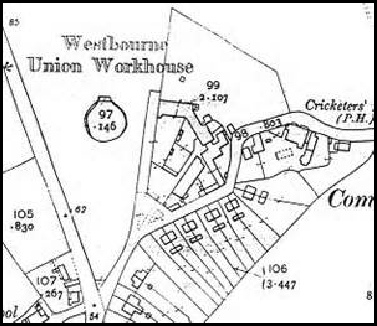WORKHOUSE
History
Fiction

WESTBOURNE
A village history in West Sussex
Home | Personal | Church | Scouts | Schools | Ambrose | Sketchbook | Workhouse | Census | Memories | Yesteryear | Publications | Village Website
UNION WORKHOUSE HISTORY
 Decision to build a Poor House in Westbourne was taken in 1773 at a Vestry Meeting. Bought the house and garden of John Day on Westbourne Common for 160 pounds. The Vestry borrowed 600 pounds to finance the purchase and development. Accepted the cheapest tender of 329 pounds from John Souter 1773.
Decision to build a Poor House in Westbourne was taken in 1773 at a Vestry Meeting. Bought the house and garden of John Day on Westbourne Common for 160 pounds. The Vestry borrowed 600 pounds to finance the purchase and development. Accepted the cheapest tender of 329 pounds from John Souter 1773.
1775 another 100 pounds to build a Springing House for "sack manufacture".
1777 alterations to the Springing House to double its size.
1810 Springing House sold to Adolpheus Miller.
1818 Enlarged by "one upright storey built over the wokshops to make room for sleeping rooms for more paupers". The Vestry in 1819 asked for several acres of land to be hired for "better employing the poor". Also in 1819 part of the Poor House was to be used as a school to "educate the infant poor".
1925 Became a Council Children's Home, finally closed in 1933, converted into flats and now replaced by private houses.
Westbourne Union was the only Union in West Sussex whose composition remained the same from 1835 to 1930. The parishes concerned were Bosham, Chidham, Compton, West Dean, Funtington, East, North and Up Marden, Racton, Stoughton, West Thorney and Westbourne.
Conditions inside the workhouse were deliberately made as harsh as possible to deter as many as possible from seeking poor relief, and the old system of 'out-
References:
The Westbourne Union, Life in and out of the New Workhouse by Ian Watson
The Poor of the Parish and the work of the Select Vestries 1819-
Published by the Westbourne Local History Group
Sources:
www.nationalarchives.gov.uk
www.newworldencyclopedia.org/entry/Workhouse
www.workhouses.org.uk/